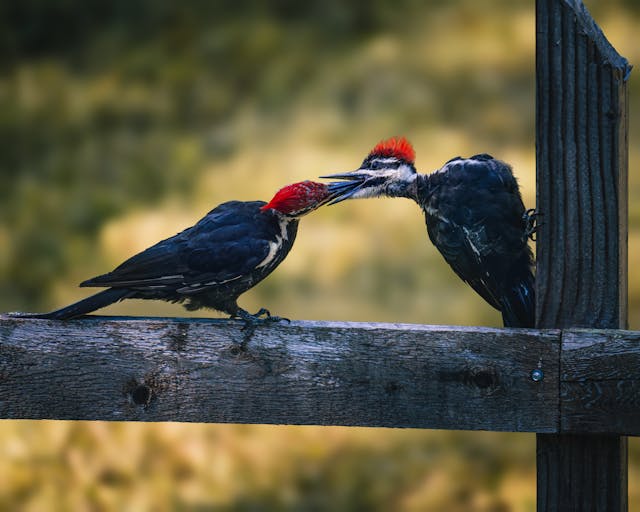Woodpeckers are among the most recognizable birds, known for their rhythmic pecking on tree trunks and their distinctive appearance. However, many people wonder if woodpeckers actually live in trees or if they just use them for feeding.
The answer is that trees are essential to woodpeckers’ lives, serving as their primary habitat for nesting, roosting, and finding food. In this article, we’ll explore how woodpeckers use trees, why they are vital to their survival, and how they adapt to life in wooded environments.
Do Woodpeckers Really Live in Trees?
Yes, woodpeckers live in trees, but their relationship with trees goes beyond finding a place to sleep. Trees provide woodpeckers with everything they need to thrive—shelter, food, and protection. Here’s how woodpeckers use trees throughout their lives:
1. Nesting Sites
Woodpeckers are cavity nesters, meaning they excavate holes in tree trunks or large branches to create nests.
These cavities are carved into dead or decaying wood, making it easier for them to chip away and create a safe, insulated space for raising their young. The woodpeckers lay their eggs inside the tree cavity, incubate them, and nurture their chicks until they are ready to fledge. The holes are usually deep and narrow to protect against predators and harsh weather conditions.
Woodpeckers typically create new nests each breeding season, meaning abandoned woodpecker cavities can later provide homes for other cavity-nesting birds, mammals, and insects, contributing to the ecosystem’s health.
2. Roosting Shelters
In addition to nesting, woodpeckers use tree cavities for roosting—seeking shelter at night or during bad weather.
Roosting cavities may differ from nesting sites; they are often smaller and may be higher up in the tree to avoid predators. Woodpeckers sometimes create multiple roosting sites in their territory, providing options depending on the season and weather conditions.
3. Foraging Grounds
Trees are a primary food source for woodpeckers. They feed on insects that live in or on tree bark, such as ants, beetles, grubs, and larvae. Woodpeckers can extract these insects by drilling into the wood, often using their long, sticky tongues to reach deep crevices.
Some species, like the sapsucker, create tiny holes in live trees to drink sap, supplementing their diet with the sweet liquid.
Additionally, woodpeckers tap on trees to locate hollow areas where insects may be hiding. This behavior, known as “drumming,” serves two purposes: finding food and communicating with other woodpeckers.
Why Do Woodpeckers Prefer Living in Trees?
Woodpeckers have several physical adaptations that make them perfectly suited for tree life:
- Strong Beaks: Woodpeckers have chisel-like beaks designed for drilling into wood. This allows them to create cavities and find food hidden beneath bark layers.
- Shock-Absorbing Skulls: Woodpeckers’ skulls are specially adapted to absorb the impact of repeated pecking, protecting their brains from injury.
- Zygodactyl Feet: Woodpeckers have two toes pointing forward and two pointing backward, giving them a firm grip on tree trunks and branches. This unique foot structure helps them easily climb vertically up and down trees.
- Stiff Tail Feathers: Their tail feathers are stiff and act as a support while they cling to vertical surfaces, helping them balance and manoeuvre around the tree bark.
Where Do Woodpeckers Choose to Live?
While all woodpeckers are associated with trees, the specific type of trees and habitat they prefer can vary by species:
- Forests: Many woodpecker species prefer dense forests with mature trees, like the Pileated Woodpecker. These areas provide abundant deadwood for nesting cavities and a rich supply of insects for food.
- Woodlands and Suburban Areas: Some woodpeckers, such as the Downy Woodpecker and the Red-bellied Woodpecker, are more adaptable and can thrive in mixed forests, parks, and even suburban backyards, where they find trees suitable for nesting and food.
- Riparian Zones: Certain woodpecker species favour riparian zones along rivers and streams because of the abundance of insects and deadwood in these moist environments.
Do Woodpeckers Ever Live Outside of Trees?
While trees are the primary habitat for woodpeckers, some species are known to adapt to living in man-made structures or other natural environments when trees are scarce:
- Utility Poles and Wooden Structures: In areas with fewer trees, woodpeckers may use utility poles, fence posts, or wooden siding on buildings as alternatives for drumming, nesting, or foraging.
- Orchards and Gardens: In some cases, woodpeckers may target fruit-bearing trees or shrubs in orchards and gardens for their food supply, especially if natural habitats are disrupted.
Do Woodpeckers Harm the Trees They Live In?
Woodpeckers generally do not harm healthy trees. They typically select trees already dead, dying, or infested with insects. Their activity can benefit tree health by controlling pest populations that could cause more significant damage. However, when woodpeckers target live trees repeatedly, it can stress the tree or provide entry points for diseases.
Species like the sapsucker may drill numerous small holes in rows on living trees to feed on sap, which can cause some damage, particularly if the same tree is targeted year after year. However, this damage is often superficial, and healthy trees usually recover without long-term effects.
Conclusion: Woodpeckers and Their Tree Homes
Woodpeckers are highly dependent on trees for shelter, food, and reproduction. Their intricate relationship with trees reflects their unique adaptations and behaviors that have evolved over millions of years. While they can occasionally cause damage, woodpeckers are crucial in maintaining healthy ecosystems by controlling insect populations and providing nesting sites for other species.
By understanding the vital role woodpeckers play in our forests and landscapes, we can better appreciate these remarkable birds and take steps to protect their habitats, ensuring they continue to thrive for generations to come.
